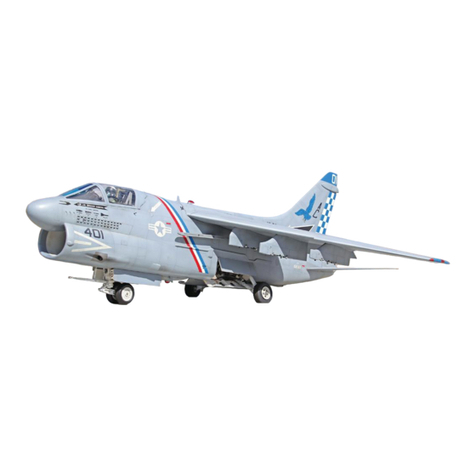
JHI-A7-06-0001
Have questions? Call us at 562-467-0260 or email larrywjhi@jethangar.com 2
TABLE OF CONTENTS
TO OUR VALUED CUSTOMERS.........................................................................4
1.0 INTRODUCTION........................................................................................5
1.1 Operation of R/C Jet Aircraft...................................................................5
1.2 The Academy of Model Aeronautics (AMA)............................................5
2.0 ABOUT THE A-7 CORSAIR II....................................................................5
3.0 GENERAL BUILDING TIPS .......................................................................6
3.1 Lightness ................................................................................................6
3.2 Adhesives ...............................................................................................6
3.3 Retracts ..................................................................................................7
3.4 Finishing .................................................................................................7
4.0 REQUIRED TOOLS AND EQUIPMENT ....................................................7
4.1 Tools ..........................................................................................................7
4.2 Adhesives...................................................................................................8
5.0 KIT CONTENTS.........................................................................................8
5.1 Turbine A-7 Packing List ............................................................................8
5.2 Ducted Fan A-7 Packing List......................................................................9
5.3 Additional Aircraft Accessories.................................................................10
5.3.1 Landing Gear........................................................................................10
5.3.2 Turbine Operation.................................................................................10
5.3.3 Ducted Fan Operation ..........................................................................10
6.0 AIRCRAFT ASSEMBLY PROCESS ........................................................11
6.1 Wing Assembly (Flaps/Ailerons)...........................................................11
6.2 Fuselage Assembly ..............................................................................12
6.2.1 Rudder ..............................................................................................12
6.2.1.1 Turbine ..........................................................................................13
6.2.1.2 Ducted Fan....................................................................................14
6.2.2 Elevator.............................................................................................15
6.2.2.1 Turbine ..........................................................................................16
6.2.2.2 Ducted Fan....................................................................................17
6.2.3 Retracts and Landing Gear ...............................................................18
6.2.4 Steering.............................................................................................21
6.2.5 Landing Gear Doors..........................................................................22
6.2.5.1 Main Gear Doors ...........................................................................22
6.2.5.2 Nose Gear Doors...........................................................................24
6.2.6 Propulsion Installation .......................................................................25
6.2.6.1 Turbine ..........................................................................................25
6.2.6.2 Ducted Fan....................................................................................27
6.2.7 Final Hardware Installation................................................................31
6.2.7.1 Turbine ..........................................................................................31
6.2.7.2 Ducted Fan....................................................................................32
7.0 AIRCRAFT SETUP AND CG ...................................................................33
8.0 FLYING THE A-7 CORSAIR II .................................................................34
8.1 Range Check ...........................................................................................34
8.2 Taxi Tests.................................................................................................34
8.3 First Flight ................................................................................................35
APPENDIX A: Coloring Diagrams/Decal Placement...........................................36
A.1 Decal Application Instructions...............................................................37




























